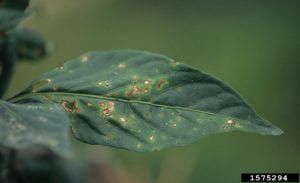Kate Everts, Vegetable Pathologist, University of Delaware and University of Maryland; keverts@umd.edu
Bacterial leaf spot (BLS) is a common and widespread disease of peppers in Maryland and Delaware. The bacterial pathogen that causes BLS is Xanthomonas campestris pv. vesicatoria. The disease may be seed borne or may become established on the crop after overwintering on Solanaceous weeds or volunteer plant hosts in the field. Tomatoes also are a host of this disease. BLS spreads by splashing rain, irrigation, or mechanically on machinery or the hands of field workers, etc.
Symptoms of BLS on pepper are small irregular spots that often have a yellow halo or border. As the disease progresses, infected leaves turn yellow and drop off the plant resulting in extensive defoliation. Disease progress in the crop is favored by high moisture and high nighttime temperatures (optimum is about 75°F).
Several tactics should be employed to reduce disease. Host resistance is available in several cultivars. Plant cultivars with resistance or tolerance to races 1, 2 and 3, which are the most common races in the Mid-Atlantic. Clean seed is important – be sure seed is treated or use hot water seed treatment. Use only clean transplants, practice crop rotation, and do not plant peppers after tomatoes.
During transplant production, apply a streptomycin spray (for example, Agri-Mycin 17 or Agri-Strep) every 4 to 5 days. Maintain good fertility in the field to help plants tolerate disease. Spread of disease can be minimized with fixed copper applications or, alternatively, a Section 2ee is available for use of Quintec for Maryland and Delaware.
Finally, the following practices will help reduce carryover of BLS to future years: control solanaceous weeds, disk the field immediately after final harvest, and do not save seed from BLS infected crops.
 Bacterial leaf spot (Xanthomonas vesicatoria) on sweet pepper
Bacterial leaf spot (Xanthomonas vesicatoria) on sweet pepper
Gerald Holmes, Valent USA Corporation, Bugwood.org
